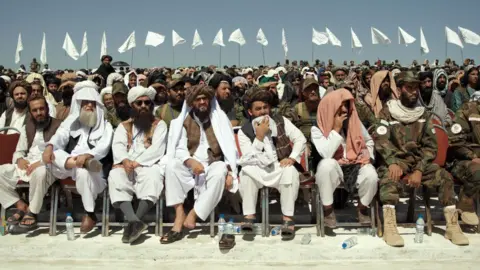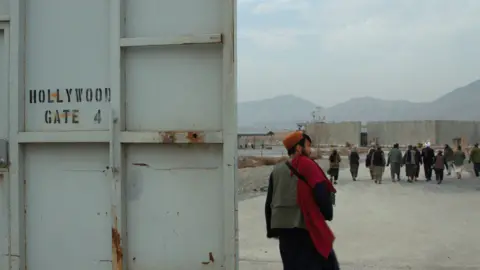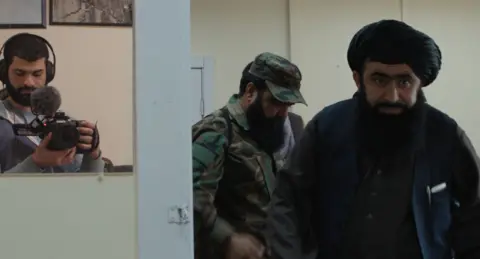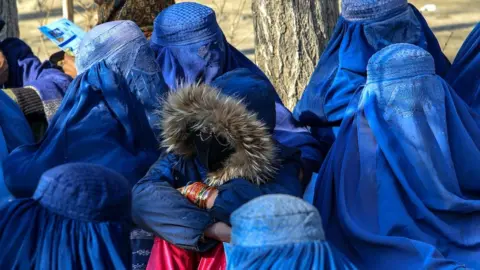Abdul Razaq Aref came to the Netherlands in 2001, sought asylum and eventually gained Dutch nationality. However, in 2012, another Dutch-Afghan reported him to the police, accusing him of having entered the country on a false identity and alleging that he was actually the former commander of Pul-e Charkhi prison during the 1980s when the Parcham faction of the People’s Democratic Party of Afghanistan (PDPA) was in power. It was a time when there was mass incarceration of anyone suspected of opposing the regime and political prisoners were routinely tortured during interrogations and kept in dire conditions. After a lengthy investigation, Aref was arrested in 2019 and put on trial in 2022.
Two former Pul-e Charkhi detainees and two Dutch prosecutors told AAN’s Ehsan Qaane ahead of his trial (see this 2020 report) that Aref had served in three different positions at Pul-e Charkhi, first, as head of the political unit of KhAD, the Parchami-era intelligence agency, the Khedamat-e Ettela’at-e Dawlati, then, deputy general director of the prison and finally its general director (rayis-e umumi). At his trial, the court was not able to verify his exact position at the prison, but did rule that, from 1 January 1983 to 1 January 1988, he had enjoyed a leadership role and been “responsible for the detention conditions and the order in prison, including the placement or transfer of prisoners.” It deemed him to have criminal liabilities both as a co-perpetrator and as a supervisor.
On 14 April 2022, Aref was found guilty on three counts: arbitrary deprivation of liberty, cruel and inhuman treatment, and assault on the personal dignity of at least 18 individual political prisoners (see judgement in Dutch, press release in English and AAN’s Ehsan Qaane reporting). Out of the tens of thousands of people who passed through Pul-e Charkhi during Aref’s time at the prison, 24 witnesses provided testimonies – nearly all of them victims – to an investigative magistrate in interviews taking place in nine countries in Europe and North America. As historian Thijs Bouwknegt wrote for the website, JusticeInfo.net, just one of the witnesses addressed the court:
On the first trial day, Abdul “W”, an elderly man with a masterly silver beard and antiquated black spectacles, sat in the middle of the courtroom. He said that some 40 years ago he was detained at Pul-e-Charkhi, an infamous jail on the eastern fringes of Kabul. His crime, the former economy student said, had been “wanting freedom for his country”. In 1984, in prison “block 3”—which he says held political prisoners – he was beaten so badly that his hand and leg were broken. Yet, it is the “psychological torture” and “flashbacks” of his lost comrades – some of whom being “buried alive” – that still intrude his sleep.
Bouwknegt reported that Aref, on the other hand, barely spoke except to say he could remember nothing.
The Pul-e Charkhi prison, a “great wheel composed of eight multi-storied blocks” on the outskirts of Kabul, held two types of prisoners. Common criminals were in one block under the control of the Ministry of Interior, and were in a small minority, according to the United Nations Mapping Report. The vast majority of those held at the prison were political prisoners, arrested and interrogated by KhAD and then transferred to the blocks in the prison which were under KhAD’s command.
The trial judges established that Aref, by virtue of his position, had been responsible for the detention conditions and order in the prison, including the placement or transfer of prisoners. It found he worked with subordinates and:
… detained persons without prior fair trial and created and maintained a detention regime in which prisoners lacked sufficient and good basic facilities, such as sanitation, food, medical care and outdoor access. Part of that regime was the use of physical violence as punishment and an atmosphere of fear, for example by placing spies in a cell. To achieve this, the suspect gave orders to his subordinates, but sometimes he also intervened himself, as evidenced by the many witness statements.
The judgement concluded:
In view of these findings, we can speak of close and conscious cooperation between the suspect and his subordinates, aimed at cruel treatment, assault on personal dignity, humiliating and degrading treatment and arbitrary deprivation of liberty of prisoners in Pul-e Charkhi prison. In the court’s opinion, the suspect’s contribution to this was of sufficient importance to consider him a co-perpetrator in those violations of international humanitarian law.
The court found Aref guilty and sentenced him to 12 years in prison.
The appeal
On 12 June 2024, Aref’s conviction was overturned by the Court of Appeal (see the verdict in Dutch and press release in English). The judges ruled in his favour not because doubt had been cast on whether he had committed the crimes he had been sentenced to, but on a point of law. The question was whether they were war crimes. The court accepted the defence’s contention that political prisoners were not necessarily held at Pul-e Charkhi because of the conflict, and therefore crimes against them could not be classed as war crimes.
Before looking at the grounds for this argument, this report first looks briefly at why the judges at Aref’s original trial decided there had been a nexus – or connection – between the crimes committed by Aref and the armed conflict.
‘Nexus’ as understood by the trial judge
The trial judges ruled that there was “a close connection between the armed conflict and the violations of international humanitarian law for which it holds the accused liable.” That original verdict held that violations had been committed against political prisoners, that is,
persons who were seen by the incumbent Afghan regime as an opponent of that regime, for example because they had spoken out against the regime or because they were affiliated with the previous regime. The detention of political prisoners in Pul-e-Charkhi prison cannot be seen as separate from the armed conflict.… [T]here was an armed conflict going on at the time between the Afghan regime, supported by the Soviet Union, and groups that opposed that regime, in particular the Mujahedin. Although it cannot be established that the political prisoners offered armed resistance to the regime, they were – at least in the eyes of the regime – among the opponents of the regime. This caused the regime to see an importance in detaining these political prisoners. This also arises from the witness statements. For example, several witnesses stated that they were accused of being against the Soviet Union or having ties to the United States, the Soviet Union’s opponent at the time. Thus, the conflict played an essential role in the opportunity for the suspect to commit the violations of international humanitarian law.
The judgement argued that the suspect had allowed detention conditions in the Pul-e Charkhi prison to deteriorate “precisely because the prisoners were political opponents.” Witnesses, it said, described the high officials in the prison seeing them as “their enemies… anti-revolutionaries.” One witness, for example, said he was punished after a spy had reported him saying he had defended the mujahedin. This section of the judgement at the trial concluded:
Detention under these circumstances could be regarded as a way to (temporarily) eliminate political opponents and ensure punishment had a ‘retributive and preventative aspect’ so that they could no longer play a role in the conflict. Thus, the conflict has also played an essential role in the purpose with which violations of international humanitarian law were committed.
‘No nexus’ as understood by the appeal court
“Making [an action] a punishable crime [strafbaarstelling],” the appeal judgement said, “is intended to provide protection against crimes that are closely related to a war.” The importance of distinguishing war crimes from common crimes lies:
… in the possibility of limiting the exceptional character of the laws of war [het oorlogsstrafrecht] to the group of offences that are appropriate. War crimes belong to the most serious category of crimes in criminal justice. In Dutch law, this is reflected, among other things, in the broad jurisdiction regulations, the fact that there is no statute of limitations, and the high maximum penalties.
This means that the laws of war have the possibilities they need, but at the same time, care must be taken against applying them too broadly. Careful application of the nexus must ensure this.
The appeals court cited guiding points in case law from the International Criminal Tribunal for Yugoslavia (ICTY) to determine whether there was a nexus in Aref’s case. It said that to be considered a war crime, the existence of an armed conflict must have played at least:
(i) a substantial role in the perpetrator’s decision to commit the crime, (ii) his ability to do so, (iii) the manner in which the crime was committed or (iv) the purpose for which it was committed.… The judge could take into account whether the perpetrator was a combatant, whether the victim was a non-combatant, or belonged to the opposing party, whether the conduct served the ultimate goal of the military campaign, and if the act was part or in the context of performing an official function.
Responding to these points, the judgement said:
The court cannot determine on the basis of the evidence that the existence of the armed conflict in this case played a substantial role in the suspect’s decision – if proven – to commit the acts [of which he was accused], his ability to do so, the manner in which he did so or the purpose thereof. Although the victims were non-combatants, it is unclear to what extent the charges were committed in the performance of the suspect’s duties – he was not a combatant, it has not been established that he had a military position, the victims did not belong to the opposing party in the armed conflict and it cannot be said that the behaviour served the ultimate goal of the military campaign.
The judge went on to say:
The KhAD was … a security/intelligence service with initially a civil and a military branch with very far-reaching powers.… [I]t cannot be established that the suspect, who falls under the KhAD, was part of the military apparatus as the Public Prosecution Service has argued. It cannot be established that it was a strictly military organisation, including with regard to its involvement in the Pul-e Charkhi prison. The available information does not indicate that the military branch was specifically responsible for it.
As to the victims, could they offer a nexus to the conflict? Some of those mentioned in the indictment were relations of the Khalqi president, Hafezullah Amin – who was murdered by Soviet commandos in December 1979, when the Soviets also installed Parchami Babrak Kamal as president – or others from Amin’s Khalq faction of the PDPA. As to other victims, all the judgement said was that they “were seen as political opponents for various reasons.”
The common denominator was that – for whatever reason – they were opponents of the regime. It was often sufficient for an arrest that someone had anti-government views or engaged in anti-government activities. However it does not appear from the file that the persons mentioned in the indictment were Mujahedin, in the sense that they belonged to the fighting group that was designated as such, nor does it appear that they were all associated with it, as the Public Prosecution Service has argued.”
The judgement went on:
The court was also unable to sufficiently determine what significance the ongoing battle with the Mujahedin had for the detention of the political prisoners. It should be borne in mind that the armed conflict with the Mujahedin was already underway before Karmal came to power in December 1979. With the appearance of the Soviet Union on the battlefield, the battle intensified, but the commitment of the Mujahedin remained the same: this group of resistance fighters defended Islam through violence and fought for Afghan values against communism, as they had done since the Saur revolution in April 1978. Moreover, the armed struggle continued after the departure of the Soviet troops in 1989.
It can also not otherwise be said that the existence of an armed conflict played a substantial role in the treatment accorded to the political prisoners. As far as anything can be determined about the purpose of the treatment, it was to propagate the ideas and positions of the communist ruling party, in other words re-education.
To sum this part of the appeal judgement up, it found that: KhAD was not necessarily military; Aref was not necessarily military; the victims were not necessarily related to the mujahedin; and it could not be determined that the armed conflict had played a substantial role in Aref’s motivation or purpose in committing the crimes he was accused of, nor his ability to do so, nor the manner in which they were carried out. The judgement appeared to cast the situation in Afghanistan as one in which there was repression of political opponents of the regime or its communist ideology that was separate from the conflict with the armed opposition.
Based on these points, the appeal court concluded that:
it cannot be established that there is a nexus between the conduct of the accused and the armed conflict. This means that these actions – if proven – do not constitute a violation of the laws and customs of war, as charged. The suspect must therefore be acquitted for this reason. For the sake of completeness, the court emphasises that the jurisdiction of the court in this case is limited to the assessment of the charged conduct insofar as it concerns a war crime. Now that, in the opinion of the court, this is not the case – due to the lack of nexus – it is not for the court to further assess the question of whether the suspect was guilty of the actual conduct referred to in the indictment.
This also means that the detention conditions in the Pul-e Charkhi prison described in the introduction as appalling and inhumane will not be discussed further in this judgment, without this detracting from how witnesses, according to their statements, experienced them.
Questions which the Supreme Court might consider
On 7 July 2024, the Dutch Public Prosecution Service announced it had filed an appeal against Aref’s acquittal with the Supreme Court, specifically contesting the appeal’s court’s determination that there was no connection between the inhuman treatment Aref had originally been convicted of and the armed conflict. For this author, the appeal court’s reasoning leads to several questions which the Dutch Supreme Court could consider, among them:
1 What sort of organisation was KhAD? Is it relevant whether it was “a strictly military organisation” or not, or had different civilian and military branches when it comes to its relevance for Aref’s crimes having a nexus with the armed conflict?
2 Is it accurate or reasonable to view the Afghan state in the 1980s as having been involved in civilian political repression separate from the armed conflict?
3 The appeals judgement referred to the determination of whether there is a nexus of crimes with an armed conflict by reference to the Criminal Tribunal for Yugoslavia (ICTY): was it comprehensive in its referencing of legal understandings reached at the ICTY?
These questions will be looked at in turn.
1. What sort of organisation was KhAD? Is it relevant if it was “a strictly military organisation” or not, or had different civilian and military branches when it comes to its relevance for Aref’s crimes having a nexus with the armed conflict?
KhAD was established by the Soviet KGB in January 1980 immediately after the invasion. In 1986, it was recast as a ministry, known by the acronym WAD. The agency was explicitly modelled on the KGB and Soviet advisors were embedded in the various centres (later renamed directorates). The agency rapidly mushroomed to become the key institution of the Parchami state, with the highest budget and the most staff. Like the personnel in the ministries of defence and interior, a UNHCR briefing noted, “All positions within the formal KhAD/WAD organigramme were ranked as military positions. Rank was determined by the level of education, and promotions in rank were based on military law.” KhAD employees had to be members of the PDPA and the agency answered directly to the president.
KhAD’s – and later WAD’s – task was, as a 2001 Dutch government report on the organisation said, to “ensure the continued short and long-term existence of the Communist regime” which in practice, meant it “had a licence to track down and fight the regime’s external and internal enemies as they saw fit.” The report went on:
The Communist regime in Afghanistan distinguished between external and internal enemies. The first group included political opponents from outside the PDPA such as left-wingers, Islamists, independent intellectuals and Mujahedin fighters. The second group included political opponents from within the PDPA, such as disloyal and disaffected fighters. In practice, the slightest sign of disloyalty or opposition provided a pretext for being branded an enemy.
Such enemies were dealt with by a criminal justice system separate from that which dealt with common criminals. KhAD was tasked with the surveillance, arrest, interrogation and incarceration of enemies of the state. Torture against opponents of the regime, said UN Special Rapporteur Felix Ermacora in 1985, was “commonplace and… has almost assumed the character of an administrative practice.” A year earlier, Amnesty International commented on how it had received reports of torture perpetrated by all the governments since the 1978 Saur Revolution but only after the formation of KhAD was torture “reported to have become systematic.” The aim of KhAD’s use of torture, said Amnesty, was to “extract information and in order to force prisoners to make a confession.”
Those accused might be tried, or just left in no-trial detention; either way they could spend months or years in prison. If they were tried, it was by the Special Revolutionary Court, also set up in 1980 and also supervised by Soviet advisors. “[T]o all intents and purposes, wrote Barnett Rubin, the Special Revolutionary Court “functioned as a branch of KhAD.” Rubin quoted then president, Babrak Kamal, who said that KhAD, the Revolutionary Prosecution Department and the Special Revolutionary Court “form one chain and one organism in the struggle.” The Special Revolutionary Courts, Rubin said, never acquitted anyone.
The Dutch appeal court’s assertion that “[a]s far as anything can be determined about the purpose of the treatment [of prisoners], it was to propagate the ideas and positions of the communist ruling party, in other words re-education [emphasis added]” is very strange. I can find no evidence for this contention in the literature, including war crimes reporting of the time. Rather, as the UN Mapping report said, “the Afghan regime and its Soviet allies maintained and enforced control in the cities through the fear of a terrorized population aware of the ever-present possibility of arbitrary arrest, torture, imprisonment, and execution.” The enforcer of this system, the report said, was KhAD. The report quoted AFP journalist Yves Heller who secured a rare press visa to visit Kabul in 1983 and described the capital as “in the grip of fear, which was visible in all the Afghans we managed to meet.” This fear, Heller said, was “methodically maintained” by KhAD, “a veritable octopus which is continually spreading its tentacles over the capital. Stories of disappearances, arrests, spying are plentiful in Kabul… where KhAD has become not just a state within a state, but the state itself.”
KhAD was largely active in urban areas – the countryside, where the regime had little control, was subject to widespread and indiscriminate bombing by Afghan and Soviet forces. However, it also had three military battalions under its Directorate for Counter-Rebellion, fighting forces tasked with carrying out frontline military operations and from 1988 onwards, a National Guard. It also ran militias, had some officers who were tasked with infiltrating mujahedin groups and conducted cross-border attacks.
The judgement refers to a military department of KhAD, and of the agency being split into a civilian and military service:
In addition to the civilian KhAD, there was a military intelligence service called the KhAD-e Nezami. This military KhAD formally operated under the Ministry of Defence. The (civilian) KhAD initially fell under the Ministry of the Interior, but in 1980 it became a fully independently operating Directorate General, falling under the Office of the President. The KhAD also carried out military tasks, such as guarding important military positions and monitoring threatened desertions, and special battalions were also set up to fight the resistance. When the KhAD became a separate ministry (WAD) in 1986, both the civilian and military KhAD were included.
From this it concludes that “it cannot be established that [KhAD] was a strictly military organisation.”
In practice, however, there was no ‘civilian KhAD’ separate from ‘military KhAD’: KhAD was one organisation, in its entirety set up in 1980. Nor did a ‘civilian’ KhAD ever fall under the Ministry of Interior. Rather, both KhAD and WAD answered directly to the president. What the judgement refers to as military KhAD was a directorate tasked with monitoring the armed forces and ensuring there was no infiltration by the regime’s enemies. It was not run out of the Ministry of Defence, but rather, as UNHCR reported, it answered to the KhAD leadership and ultimately the president:
[T]he Military and Police KhAD/WAD were structures situated respectively within the Ministries of Defense and the Interior, responsible for counter-intelligence and prevention of infiltration by enemies of the regime, in particular Mujaheddin groups. They maintained their reporting lines to KhAD/WAD.
Whether KhAD was military or civilian – and it clearly had a mixed role – seems irrelevant. It was established concurrent with the Soviet invasion and expanded as the resistance grew. If it had been purely civilian, this would also not seem relevant; a civilian or employee of a civilian organisation can also commit war crimes. Moreover, at this time, it was not just the PDPA armed forces that were engaged in fighting real and perceived armed and unarmed resistance – it was the entire state apparatus. KhAD, a huge agency with a tentacular reach and multiple aspects to its work, was at least as important as the armed forces in that fight.
As to Aref’s role within it, two sentences in the judgement stand out in this context:
[I]t is unclear to what extent the charges were committed in the performance of the suspect’s duties … and it cannot be said that the behaviour served the ultimate goal of the military campaign.
The charges against Aref were absolutely carried out as part of his duties overseeing Pul-e Charkhi. It is hard to see how the judges thought this might not be the case. As to whether his behaviour served the military campaign, causing fear and suffering, physically harming, degrading and humiliating prisoners would seem a very direct way of deterring opposition and, as the original trial judges said, temporarily eliminating political opponents and ensuring the sort of punishment that meant they no longer played a role in the conflict.
2. Is it accurate or reasonable to view the Afghan state in the 1980s as having been involved in civilian political repression separate from the armed conflict?
The judgement cast the armed conflict as having been between the PDPA state and its Soviet backers and the mujahedin. It twice referred to the mujahedin as a ‘group’, including saying that the mujahadin “consisted of various sub-groups, both Sunni and Shia in nature.” In fact, the various mujahedin tanzims (military-political factions), each had their own command and control structure, were unrelated to the others and were, in some cases, deadly rivals. This was not one group.
Moreover, not all Afghans involved in the armed resistance were mujahedin. In another war crimes trial in the Netherlands, for example, victims were from the leftist group, SAMA (see the guilty verdict in the 2005 case brought against another senior figure in KhAD, Hesamuddin Hesam, for torture, in breach of the laws and practices of war). AAN’s Thomas Ruttig has given a detailed rendering of the “the parties during the war of resistance,” relayed here in full as it accurately describes the multitudinous scope of the anti-PDPA, anti-Soviet groups in the 1980s.
The Islamists only rose to importance after the PDPA’s 7th Saur coup (or the Saur Revolution, as the PDPA called it) in 1978 and, in particular, after the Soviet invasion of Christmas 1979. They profited from the enormous amount of military and financial aid, coming mainly from the USA and Saudi Arabia and channelled through the ISI, and from the Pakistani decision in May 1979 to limit the flow exclusively to the Sunni Islamist ‘Peshawar Seven’, the so-called tanzim that constituted the haftgana or ‘Alliance of Seven’. The nationalist and leftist resistance groups were cut off from supplies. Pakistan also stopped two attempts to convene a Loya Jirga that would have reinforced the tribal elites vis-à-vis the Islamists.
Right at the beginning of the resistance war the Islamists split into various tanzim. Attempts by Pakistan and the USA to establish an umbrella organisation only resulted in short-term unity and then the establishment of new factions. Harakat-e Inqelab-e Islami, or ‘Islamic Revolution Movement’, and Ittehad-e Islami bara-ye Azadi-ye Afghanistan, or ‘Islamic Union for the Freedom of Afghanistan’, were both meant to be alliances but soon turned into new factions, led by Muhammadi and Sayyaf. …
Resistance by Shia groups can be divided into two phases: a ‘successful popular resistance movement’ between 1978-83, led by Shura-ye Inqilabi-ye Ittifaq-e Islami-ye Afghanistan, or ‘Revolutionary Islamic Unity Council of Afghanistan’, and the ‘in-fighting’ period which resulted from the ‘emergence of Hazara groups backed by Iran’. Shia resistance started in a very fragmented way; Bradsher counted ‘at least 37 factions’ by the summer of 1979. The Shura, a conservative Islamic organization, came into being when the leaders of the rebellion, mainly from the old khan elite from almost all Hazara areas, came together in September 1981, setting up a parallel administration in areas under its control… From 1983 onwards, the leadership in Tehran pushed Khomeinist groups from the Afghan diaspora, mainly Pasdaran and Nasr. They brutally suppressed the Shura and its social base in what amounted to an inner-Hazara civil war. In 1987, Tehran forced the eight major Shia groups – the so-called hashtgana or ‘Tehran Eight’ – to unite in Shura-ye I’tilaf-e Islami-ye Afghanistan, or ‘Islamic Coalition Council of Afghanistan’, from which, in 1989, Hezb-e Wahdat-e Islami, or ‘Islamic Unity Party’, was created. This was first led by Abdulali Mazari (killed 1995) and then by Abdulkarim Khalili. The non-Hazara Harakat-e Islami-ye Afghanistan, or ‘Islamic Movement of Afghanistan’, under its religious leader Sheikh Asef Mohseni, soon opted out leaving the predominantly Hazara Hezb-e Wahdat as the only active Shia group. Within Hezb-e Wahdat, the constituent groups maintain some coherence until today, particularly in rural areas. The Mustaza’fin retained some degree of organisational independence throughout this period… In addition to the Peshawar Seven and the Tehran Eight, dozens of other armed groups continued to fight the Soviets – and for their own organisational survival.
At least in the first years, the Maoist groups continued highly intense guerrilla warfare against the new regime. Meanwhile, Settam-e Melli/SAZA became less active, in particular after the Pashtun PDPA leaders were replaced by Tajik speaker, Babrak Karmal, following the Soviet invasion. One of the most successful resistance groups was Sazman-e Azadibakhsh-e Mardom-e Afghanistan (SAMA), or ‘People’s Liberation Organisation of Afghanistan’, formed in the summer of 1979 by Abdulmajid Kalakani. Although generally labelled ‘Maoist’, it was in fact a mixture of former Shola’i, non-conformist leftists like its legendary leader, and groups of outlaws politicised by him. In January 1980, SAMA initiated a broader alliance that included some ex-Shola’i and ex-Settami groups, left-wing Pashtun nationalists, and religious leaders like the Pir of Obeh from Herat province, called Jabha-ye Muttahed-e Melli-ye Afghanistan, or ‘National United Front of Afghanistan (NUFA)’, which continued to follow Kalakani’s republican ideals. SAMA soon came under military pressure from Jam’iat and Hezb. Kalakani was arrested in February 1980 and executed four months later. Some SAMA leaders negotiated a surrender with the government which led to further splits.
Other leftist underground groups were Paikar (full name Sazman-e Paikar bara-ye Raha’ibakhsh-e Afghanistan, or ‘Struggle Organisation for the Liberation of Afghanistan’) – the successor to SuRKhA (Sazman-e Rahayibakhsh-e Khalqha-ye Afghanistan, or ‘Liberation Organisation of Afghanistan’s Peoples’) which was destroyed by the regime –, Raha’i (Sazman-e Raha’ibakhsh-e Khalqha-ye Afghanistan, or ‘Afghanistan’s Peoples’ Liberation Organisation’), and Sazman-e Feda’ian-e Zahmakashan-e Afghanistan (SAFZA), or ‘Feda’ian Organisation of Afghanistan’s Toilers’, a Settam-e Melli offshoot. After an ill-prepared uprising in Badakhshan in August 1979, its leader Maulawi Bahauddin Ba’es who considered himself an ‘Islamic socialist’, was put into prison and killed. Other SAFZA leaders re-joined PDPA in 1984.
It is simply incorrect to render the armed conflict in the 1980s as one solely between the PDPA/Soviet Union and the mujahedin group, or even mujahedin.
Moreover, what is important in the context of the appeal court’s verdict is that, regardless of the particular motivation of the government’s opponents, or what category of opposition the state perceived individuals as belonging to, it treated them the same, whether they were or were accused of being Shia or Sunni mujahedin, leftist, independent intellectuals, Maoist or Khalqi. It is just not possible to disentangle the state’s actions, structures, institutions and mechanisms in terms of how it dealt with political and armed opponents.
Here, it is also worth stressing a particular flaw in the appeals judgement is that, apart from mentioning the relatives of former President Amin and other Khalqis, there is no detail about the other prisoners, and no case-by-case argument as to why, for each, there was no nexus with the armed conflict.
3. The appeals judgement referred to the determination of whether there is a nexus of crimes with an armed conflict by reference to the Criminal Tribunal for Yugoslavia (ICTY): was it comprehensive in its referencing of legal understandings reached at the ICTY?
One important understanding that emerged in both the International Criminal Tribunals for Yugoslavia (ICTY) and Rwanda (ICTR), over whether a particular crime has a nexus to an armed conflict was summed up in these paragraphs from Rwandan Georges Rutaganda’s failed 2003 appeal against his 1999 life sentence. He had been found guilty of genocide, crimes against humanity and violations of common article 3 (murder). Some of this language was echoed in the appeals court ruling on Aref, but not all:
What ultimately distinguishes a war crime from a purely domestic offence is that a war crime is shaped by or dependent upon the environment – the armed conflict – in which it is committed. It need not have been planned or supported by some form of policy. The armed conflict need not have been causal to the commission of the crime, but the existence of an armed conflict must, at a minimum, have played a substantial part in the perpetrator’s ability to commit it, his decision to commit it, the manner in which it was committed or the purpose for which it was committed. Hence, if it can be established, as in the present case, that the perpetrator acted in furtherance of or under the guise of the armed conflict, it would be sufficient to conclude that his acts were closely related to the armed conflict. The Trial Chamber’s finding on that point is unimpeachable.
In determining whether or not the act in question is sufficiently related to the armed conflict, the Trial Chamber may take into account, inter alia, the following factors: the fact that the perpetrator is a combatant; the fact that the victim is a non-combatant; the fact that the victim is a member of the opposing party; the fact that the act may be said to serve the ultimate goal of a military campaign; and the fact that the crime is committed as part of or in the context of the perpetrator’s official duties.
This Chamber agrees with the criteria highlighted and with the explanation of the nexus requirement given by the ICTY Appeals Chamber in the Kunarac Appeal Judgement. It is only necessary to explain two matters. First, the expression “under the guise of the armed conflict” does not mean simply “at the same time as an armed conflict” and/or “in any circumstances created in part by the armed conflict”. For example, if a non-combatant takes advantage of the lessened effectiveness of the police in conditions of disorder created by an armed conflict to murder a neighbour he has hated for years, that would not, without more, constitute a war crime under Article 4 of the Statute. By contrast, the accused in Kunarac, for example, were combatants who took advantage of their positions of military authority to rape individuals whose displacement was an express goal of the military campaign in which they took part. Second, as paragraph 59 of the Kunarac Appeal Judgement indicates, the determination of a close relationship between particular offences and an armed conflict will usually require consideration of several factors, not just one. Particular care is needed when the accused is a non-combatant.
If it became necessary to establish that a perpetrator had been motivated only by wanting to further an armed conflict, there would be effective impunity from war crimes law for anyone who took advantage of a war and their official position within it to carry out, for example, murder or rape. In Aref’s case, the question should at least be asked as to whether his crimes were perpetrated under the guise of the armed conflict and/or whether the conflict enabled him to commit his crimes.
Repercussions of Aref’s appeal verdict
The Netherlands has had a relatively good track record of bringing accusations of old war crimes to court (see AAN’s 2020 report on those involving Afghans). These cases are difficult. The Afghan cases, in particular, date back decades, making witness testimony tricky. The alleged crimes took place in another country, about which the court will not have the same sort of knowledge as its own.
In Aref’s appeal, the points of substance which the appeal court may have got wrong – casting KhAD and Aref as non-military and therefore with no necessary nexus to the armed conflict, and the Parchami government’s repression of a civilian opposition as having been separate from its pursuit of the armed conflict are troubling. More problematic though is the court not taking into consideration the possibility that Aref acted under the guise of the armed conflict, in line with the legal understanding reached at the ICTY and ICTR.
Aref is now a free man and if his acquittal is upheld, he will be due financial compensation from the Dutch government for the years he has spent in prison. Even if the Supreme Court agrees with the prosecution’s argument that his actions did, in fact, have a nexus to the armed conflict, it can only refer the case back to the high court. In the best case scenario – from the victims’ point of view – the legal process is destined to take years. At best, therefore, Aref would be very old before he might again see the inside of a Dutch prison. For Aref’s many victims – and those who testified to the court were a tiny fraction – the appeal court’s verdict will have been a bitter blow, as they see justice – hard won and after so many years – again slipping away from them.
Edited by Martine van Bijlert and Roxanna Shapour


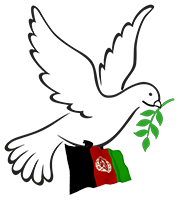 Afghanistan Peace Campaign
Afghanistan Peace Campaign
